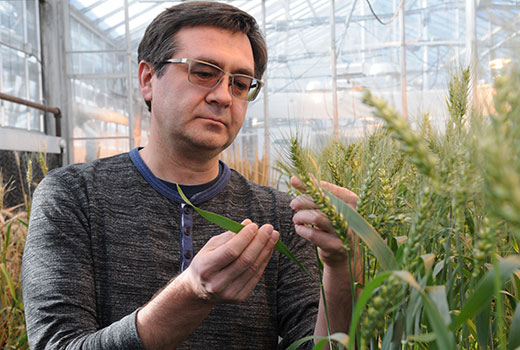
Kansas State University wheat geneticist and pathologist Eduard Akhunov works recently in the university's greenhouse. K-State researchers and colleagues from two U.S. universities have identified close to 1 million markers in the genome of 2400 wheat lines, work that will lead to faster and more efficient improvements in wheat varieties. | Download this photo.
K-State researchers unveil new genetic resource to improve wheat
Study develops a resource to help breeders, geneticists link traits to genes
August 18, 2018
MANHATTAN, Kan. – After a long-term study in which they evaluated massive amounts of information from the wheat genome, Kansas State University researchers and colleagues from Montana State University and the University of California-Davis have released a genetic resource that opens the door to faster and more efficient improvements to one of the world’s most-grown crops.
Eduard Akhunov, a K-State professor of wheat genetics and pathology, said the scientists can now use 2400 wheat lines developed in the study to gain specific genetic information on how to improve numerous traits in future varieties, including boosting yields and increasing resistance to pests, disease and drought.
“One of the main things we do as wheat geneticists is we identify genes that control agronomic traits so that later on we can develop tools and resources for improving wheat,” Akhunov said.
Recently, the International Wheat Genome Sequencing Consortium – a group of more than 1,500 members in 60 countries that was formed in 2005 – released the sequence of the wheat genome with more than 100,000 identified genes. That key milestone opened new possibilities for wheat scientists to start characterizing the functional role of each gene, according to Akhunov.
“Now that we know all the genes in the wheat genome, we need to start figuring out what each gene is doing and how each gene contributes to a trait,” Akhunov said.
He added: “The genetic resource we developed can help to accelerate the progress in understanding the function of many genes in the wheat genome.”
For the past year and a half, K-State scientists used gene sequencing tools to characterize genetic variation in many genes along the wheat genome, considered the most complex genome of all farm crops.
They analyzed nearly 10,000 wheat lines from around the world, then selected 28 of the most genetically and geographically diverse wheat lines. The scientists then crossed the 28 lines to build a population of 2400 wheat lines.
Using a molecular technique called next-generation sequencing, K-State’s research team identified close to 1 million markers in the genome for each of the 2400 wheat lines – giving them nearly 2.4 billion data points that were analyzed to build the map of gene sequence variation across the entire wheat genome.
“This (data) resource allows us to identify genes that control numerous agronomic traits,” Akhunov said. “Because we were studying the most genetically diverse set of wheat lines, it does capture the maximum diversity of what exists in wheat at this moment.”
Katie Jordan, a research assistant professor of plant pathology, spent nearly a full year analyzing the data and generating maps that now will become part of a public resource where wheat geneticists and breeders can quickly access information to map genes for improving future wheat varieties.
“We did the research to put that in place so that the next person who wants to measure a trait can start with all of that genetic data, link it to the trait and get results pretty quickly,” Jordan said.
In addition to improving yield or resistance to pests, disease and drought, the project included studying genes that control flowering time, heading dates, seed size, grain weights and many more traits important to bringing in a good crop.
Akhunov said an exciting finding was that Jordan identified genes that relate to the efficiency of breeding new wheat lines.
“When you cross breeding lines in the breeding program, what you are really trying to do is re-shuffle the genetic material of the two lines that you cross,” Akhunov said. “The efficiency and the rate with which the re-shuffling happens is actually genetically controlled, so we need to identify genes that allow us to accelerate the rate of genetic material exchange in the breeding process.”
That process is called recombination, and by making it more efficient, it decreases the time needed to make a successful cross – ultimately meaning that successful wheat varieties get to the farmer more quickly.
K-State’s research was funded by the USDA's National Institute for Food and Agriculture’s Wheat Coordinated Agricultural Project (Wheat-CAP), which is part of the International Wheat Yield Partnership, a large international effort to improve wheat production. The study is published in The Plant Journal, which is available online here.

